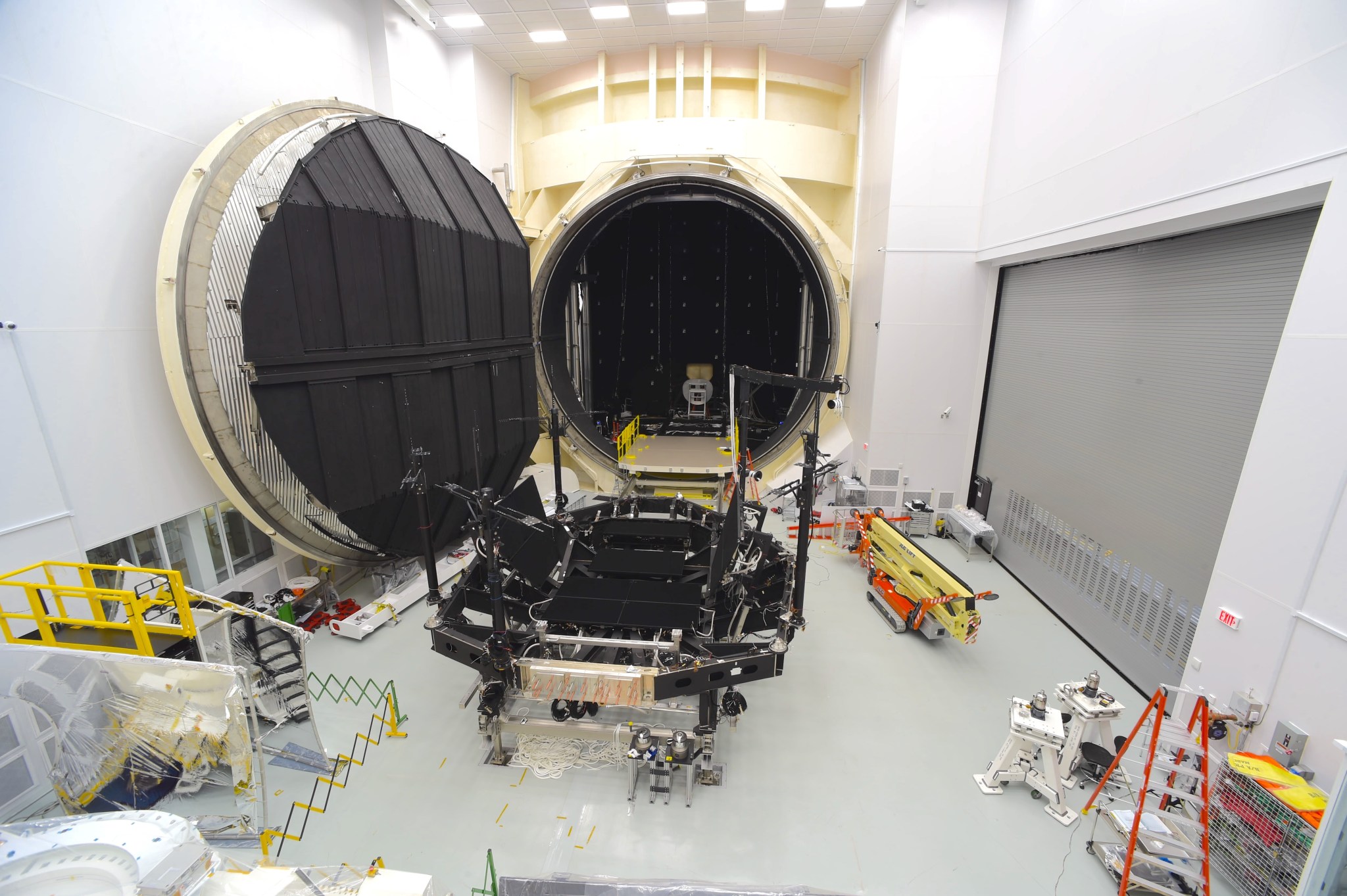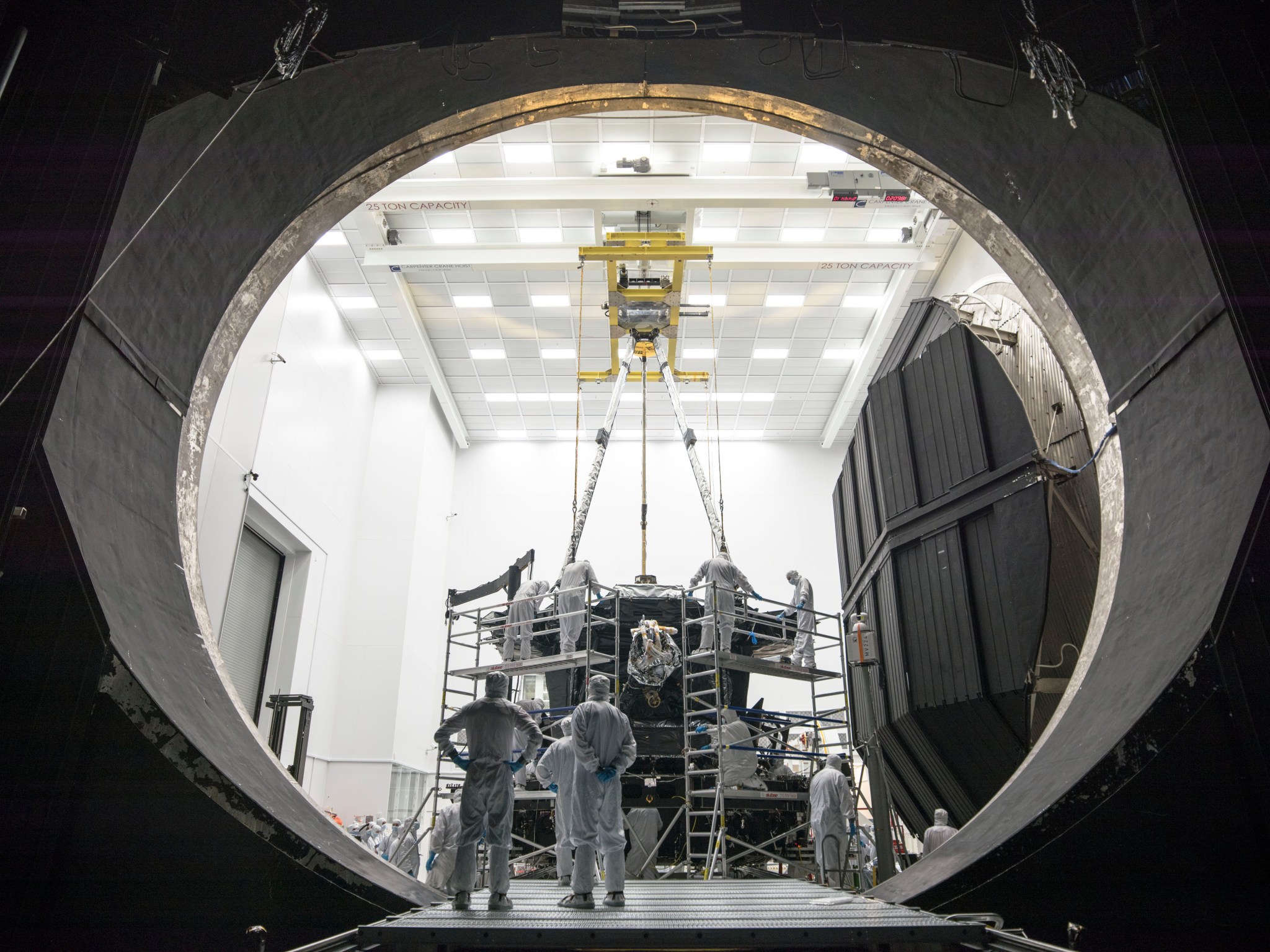NASA’s “Chamber A,” an enormous thermal vacuum testing chamber housed at NASA’s Johnson Space Center in Houston, Texas, is now ready to conduct final optical testing on NASA’s James Webb Space Telescope (Webb telescope), the largest space observatory ever. A National Historic Landmark, Chamber A is famous for being used to test Apollo moon mission hardware, including suited astronauts inside the chamber on occasion. In order to test Webb prior to launch, the chamber had to undergo major upgrades in the last several years.

Chamber A’s upgrades were accomplished by engineers and technicians from NASA’s Johnson Space Center in Houston, Texas, and NASA’s Goddard Space Flight Center in Greenbelt, Maryland, including their contractor teammates, most notably from Jacobs Engineering and Harris Corporation. Some changes were made to the chamber and the surrounding facility and others were made to the design, construction, and installation of test equipment.
“In this partnership, Johnson will operate the chamber and Goddard will run the testing,” said Paul Geithner, the James Webb Space Telescope project technical manager. “We’ve run multiple tests of everything, so we know it all works before using it this summer to test the flight hardware, which is the telescope plus integrated science instrument module.”
Webb’s telescope and the Integrated Science Instrument Module (ISIM) are two of the three major elements that comprise the Webb telescope Observatory flight system. The other is the Spacecraft Element (spacecraft bus and sunshield), which is currently under construction at Northrop Grumman Aerospace Systems (NGAS) in Redondo Beach, California.
With the upgrades necessary for testing the Webb telescope finally complete, Chamber A is now the largest high-vacuum, cryogenic-optical test chamber in the world. It is 55 feet (16.8 meters) in diameter by 90 feet (27.4 meters) tall. The main door alone is 40 feet in diameter (12.2 meters), weighs 40 tons, and is opened and closed hydraulically.
Out With the Old

Some Apollo-era legacy equipment was removed, such as a ‘lunar platform’ floor and solar simulation high-intensity lamps from inside the chamber. “Then, the 50-year-old facility’s infrastructure, like the chilled water cooling system and air conditioning, backup power and the power feed, chamber clean airflow system, and building integrity (e.g., roof weatherproofing) were updated, refreshed, and improved,” Geithner said.
In With the New
One of the things that was newly constructed and installed in Chamber A was a cold gaseous helium-cooled ‘shroud’ that enables the chamber to reach colder temperatures than it had ever reached before. This addition was necessary because Webb’s telescope and scientific ‘instruments’ (cameras and spectrometers) will operate at temperatures of around 37 Kelvin (K), which is around minus 393 Fahrenheit (F) / minus 236 Celsius (C). Chamber A previously had only a liquid nitrogen shroud inside, and because liquid nitrogen is 77K, you couldn’t get test articles any colder than that. “We added a cold helium gas shroud that we’ve run down to about 11K, which is (minus 440 F/minus 262 C, thus enabling us to get the telescope to its operating regime and even to as low as around 20K to reach ’survival’ temps,” Geithner said.
Testing the Webb telescope requires a high vacuum and extremely low temperatures. The telescope also needs an arrangement that holds it and its test equipment in precise relative alignment inside the chamber while isolated from any sources of vibration, such as the flow of nitrogen and helium inside the shroud plumbing and the rhythmic pulsing of vacuum pumps. The engineers installed a massive steel platform suspended from six steel rods (vibration isolators) about 60 feet long (18.2 meters) each and about 1.5 inches (or 38.1 mm) in diameter, to hold the telescope and key pieces of test equipment. They installed sophisticated optical telescope test equipment including an interferometer, auto-collimating flat mirrors, and a system of photogrammetry ‘precision surveying’ cameras, and they already did tests with a surrogate ‘pathfinder’ telescope.
Webb is always kept in a clean environment to prevent dust and dirt from degrading its performance. The inside of Chamber A is clean, but unpacking, unfolding, re-folding and re-packing the Webb telescope requires a lot of space and therefore needed to be handled outside the chamber. So, engineers at NASA Johnson built a large cleanroom around the gaping entrance to Chamber A. The cleanroom provides room for the telescope to be hoisted from its shipping container and ‘unwrapped’ from protective bagging, deployed, rotated from horizontal to vertical, placed on its test platform, and finally slid into the chamber on rails and hung from the six long suspending rods, all in an ultra-clean environment. Even though the new cleanroom is big, it is barely large enough for these activities.
“The Goddard Space Flight Center and Johnson Space Center were responsible for the tremendously successful Hubble Space Telescope servicing missions,” said Eric P. Smith, the director of the program, NASA Headquarters, Washington. “It’s great to have the two centers team up again for this critical test of Webb, which is the scientific successor to Hubble.”
Once telescope testing is complete, this sequence will run in reverse and the telescope will be shipped to Northrop Grumman Aerospace in California to meet up with the Spacecraft Element and finally become one complete James Webb Space Telescope observatory.
Testing, Testing, Testing
Credits: NASA/Sophia Roberts
The telescope was transported from NASA Goddard to NASA Johnson on May 4, 2017. After several weeks of unpacking, deploying, and instrumenting for the test, the chamber door will be closed and the flight hardware will be tested around-the-clock for 93 straight days. In the beginning, it will take a few weeks for everything inside the chamber to cool down and reach steady cryogenic temperatures, and similarly at the end it will take the final few weeks for everything to warm up to room temperature again, but every minute of the entire 93 days is jam-packed with specific tests to verify that the telescope performs as designed and will operate as it should in space.
To view a “Chamber A” image feature visit: https://www.nasa.gov/image-feature/goddard/2017/nasas-james-webb-space-telescope-says-open-wide-to-chamber-a
For more information about the Webb telescope, visit: www.jwst.nasa.gov or www.nasa.gov/webb
By Rob Gutro
NASA’s Goddard Space Flight Center

























